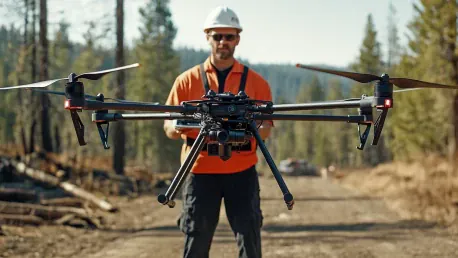In recent years, South Africa has seen an increased reliance on advanced technology to manage disaster situations efficiently, and drones have emerged as indispensable tools in this endeavor. These unmanned aerial vehicles (UAVs) offer significant benefits by providing real-time data, high-resolution imagery, and rapid assessment capabilities. Their ability to swiftly evaluate damage, facilitate search-and-rescue operations, deliver essential supplies, and monitor ongoing hazards is revolutionizing emergency response efforts. This article delves into various aspects of how drones are transforming disaster management in South Africa, examining the critical roles they play and the growing importance of drone insurance.
Rapid Damage Assessment
One of the notable advantages of drones in disaster management is their capacity for rapid damage assessment following natural catastrophes, such as floods, fires, and earthquakes. In a country like South Africa, where such events can significantly affect infrastructure and communities, drones play a vital role in evaluating the extent of the damage. The ability to obtain immediate assessments is crucial for planning emergency responses and prioritizing actions, helping authorities allocate their resources most effectively.
According to Kopano Tholo, a drone expert at ITOO Special Risks, UAVs are instrumental in creating detailed two-dimensional and three-dimensional maps through aerial reconnaissance. These capabilities are essential in areas that are difficult to access by other means, allowing rescuers to identify potential hazards and prioritize relief efforts effectively. Drones equipped with high-resolution cameras and advanced sensors capture detailed imagery and data quickly, providing accurate assessments of the affected zones. This rapid and precise data collection enables authorities to identify the most impacted areas promptly, facilitating efficient planning and execution of rescue and recovery operations.
Search-and-Rescue Operations
Another significant advantage drones offer is their effectiveness in search-and-rescue missions. Drones can cover large areas quickly, making them indispensable in situations where time is of the essence. Equipped with thermal imaging cameras, drones can detect heat signatures from individuals trapped under debris or lost in isolated locations, even in low-light conditions. This feature is particularly crucial in disaster situations, as it significantly increases the chances of promptly locating survivors and initiating rescue operations without delay.
Historically, drones have been credited with saving numerous lives in disaster situations worldwide. For instance, during the 2017 Mexico City earthquake, drones played a pivotal role in identifying and locating survivors trapped under rubble, thus enhancing the efficiency of rescue missions. By providing aerial perspectives that are difficult to achieve with traditional methods, drones offer a critical advantage in swiftly and accurately detecting the locations of survivors, thereby optimizing rescue efforts and maximizing the chances of saving lives.
Delivery of Essential Supplies
In disaster scenarios where traditional access routes are blocked or destroyed, drones prove invaluable in delivering essential supplies to isolated communities or individuals. South Africa has faced numerous situations where roadways were rendered impassable, making conventional transportation methods impractical. Drones can quickly and safely deliver critical supplies such as medical kits, food, and water to those in need, ensuring timely assistance in otherwise inaccessible areas.
This ability to expedite relief efforts not only accelerates the provision of aid but also reduces the risk to human responders who would otherwise face hazardous conditions. The efficiency and safety afforded by drones in transporting essential supplies mark them as game-changers in emergency response. By significantly cutting down delivery times and bypassing impediments on the ground, drones enable relief agencies to offer prompt and effective aid, which is crucial in mitigating the immediate impacts of disasters and stabilizing affected populations until comprehensive recovery efforts are mobilized.
Monitoring Ongoing Hazards
Beyond initial disaster response, drones are highly effective in monitoring ongoing hazards such as wildfires, chemical spills, or floods. Providing real-time data on the progression of these events is critical for implementing effective containment strategies, evacuating at-risk populations, and preventing further damage. The continuous monitoring capabilities of drones allow emergency responders to adapt their strategies in real-time, ensuring that protective measures remain effective as conditions evolve.
Post-disaster, drones also contribute to the inspection of critical infrastructure like bridges, roads, and power lines to assess damage and prioritize repairs. This accelerates the restoration of essential services and aids the recovery process. In the aftermath of a disaster, timely recovery of infrastructure is vital for returning communities to normalcy, and drones provide the rapid assessment and detailed information needed to expedite this process. By enabling targeted and efficient repairs, drones play a crucial role in minimizing the long-term disruptions caused by disaster events.
The Importance of Drone Insurance
As drone technology becomes more pervasive in disaster management, the need for comprehensive drone insurance has become increasingly evident. The drone insurance market has grown significantly, reflecting the expanded use of UAVs in various emergency response scenarios. Kopano Tholo advises that drone insurance should be a fundamental consideration for all operators engaged in disaster management in South Africa. Comprehensive insurance measures safeguard both the operators and the communities they serve, providing financial protection against potential damages or injuries incurred during high-risk operations.
Insurance coverage protects not only the drone operators but also the individuals and property that may be impacted in case of an accident or malfunction. Given the potential legal liabilities associated with commercial drone operations, this protection becomes crucial in ensuring operational continuity during critical disaster response efforts. Regulatory frameworks in many African countries, including South Africa, require operators to have liability cover to operate drones for commercial purposes, underscoring the importance of securing appropriate insurance for UAV operations in disaster management.
Mitigating Risks and Future Considerations
In recent years, South Africa has increasingly relied on advanced technology to handle disaster scenarios more efficiently. Drones, or unmanned aerial vehicles (UAVs), have proven to be indispensable in this effort. These high-tech tools provide real-time data, high-resolution imagery, and rapid assessment capabilities. The ability of drones to quickly evaluate damage, support search-and-rescue operations, deliver essential supplies, and monitor ongoing hazards is revolutionizing emergency response efforts. This article explores various ways in which drones are transforming disaster management in South Africa. It examines the critical roles these devices play in enhancing efficiency and effectiveness in emergencies and highlights the growing importance of drone insurance. As technology advances, the integration of drones is becoming essential for better disaster response and prevention strategies, showcasing their value as vital assets in managing crisis situations.









